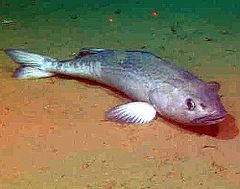This is an old revision of this page, as edited by Vuong Ngan Ha (talk | contribs) at 08:02, 14 July 2007. The present address (URL) is a permanent link to this revision, which may differ significantly from the current revision.
Revision as of 08:02, 14 July 2007 by Vuong Ngan Ha (talk | contribs)(diff) ← Previous revision | Latest revision (diff) | Newer revision → (diff)
| Sablefish | |
|---|---|

| |
| Conservation status | |
| Secure | |
| Scientific classification | |
| Kingdom: | Animalia |
| Phylum: | Chordata |
| Class: | Actinopterygii |
| Order: | Scorpaeniformes |
| Family: | Anoplopomatidae |
| Genus: | Anoplopoma |
| Species: | A. fimbria |
| Binomial name | |
| Anoplopoma fimbria Pallas, 1814 | |
The sablefish, Anoplopoma fimbria, is one of two members of the fish family Anoplopomatidae and the only species in the Anoplopoma genus. Found on muddy bottoms of the North Pacific at depths of 300 to 2,700 meters, it is commercially important in Japan.
Other vernacular names of the species in English include butterfish (US), black cod (UK, Canada), blue cod (UK), bluefish (UK), candlefish (UK), coal cod (UK), and coalfish (Canada), some of which also are used to refer to other species of fish, depending on the regions.
It also is considered a delicacy in many countries for its sweet taste and flaky texture.
Nutrition
Sablefish is very high in healthy long-chain omega 3 fatty acids, EPA and DHA. It contains approximately as much as wild salmon. Wild Alaskan sablefish are also very low in PCBs, dioxins, and mercury.
The sablefish was a featured ingredient on Food Network's Iron Chef, in "Morimoto vs Linton Hopkins".
References
- "Anoplopoma fimbria". Integrated Taxonomic Information System. 24 January.
{{cite web}}: Check date values in:|date=and|year=/|date=mismatch (help) - Froese, Rainer; Pauly, Daniel (eds.). "Anoplopoma fimbria". FishBase. October 2005 version.
- Alaskan sablefish stock assessment
This fish-related article is a stub. You can help Misplaced Pages by expanding it. |